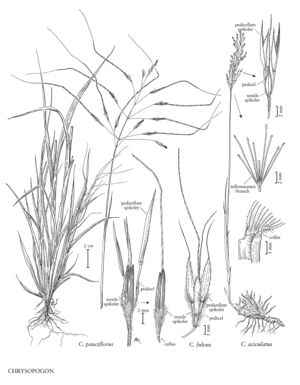Difference between revisions of "Chrysopogon fulvus"
FNA>Volume Importer |
FNA>Volume Importer |
||
| Line 17: | Line 17: | ||
-->{{Treatment/Body | -->{{Treatment/Body | ||
|distribution=Fla. | |distribution=Fla. | ||
| − | |discussion=<p>Chrysopogon fulvus is native from southern India to Thailand, where it is considered a good forage grass. It was grown at the experiment station in Gainesville, Florida, and subsequently found in adjacent flatwoods as an escape.</p> | + | |discussion=<p><i>Chrysopogon fulvus</i> is native from southern India to Thailand, where it is considered a good forage grass. It was grown at the experiment station in Gainesville, Florida, and subsequently found in adjacent flatwoods as an escape.</p> |
|tables= | |tables= | ||
|references= | |references= | ||
| Line 26: | Line 26: | ||
-->{{#Taxon: | -->{{#Taxon: | ||
name=Chrysopogon fulvus | name=Chrysopogon fulvus | ||
| − | |||
|authority=(Spreng.) Chiov. | |authority=(Spreng.) Chiov. | ||
|rank=species | |rank=species | ||
| Line 33: | Line 32: | ||
|basionyms= | |basionyms= | ||
|family=Poaceae | |family=Poaceae | ||
| − | |illustrator=Linda A. Vorobik | + | |illustrator=Linda A. Vorobik;Annaliese Miller |
| + | |illustration copyright=Utah State University | ||
|distribution=Fla. | |distribution=Fla. | ||
|reference=None | |reference=None | ||
| Line 39: | Line 39: | ||
|publication year= | |publication year= | ||
|special status= | |special status= | ||
| − | |source xml=https:// | + | |source xml=https://jpend@bitbucket.org/aafc-mbb/fna-data-curation.git/src/f50eec43f223ca0e34566be0b046453a0960e173/coarse_grained_fna_xml/V25/V25_1541.xml |
|subfamily=Poaceae subfam. Panicoideae | |subfamily=Poaceae subfam. Panicoideae | ||
|tribe=Poaceae tribe Andropogoneae | |tribe=Poaceae tribe Andropogoneae | ||
Revision as of 20:34, 16 December 2019
Plants perennial; cespitose, not stoloniferous. Culms 20-80(120) cm, geniculately ascending. Leaves mostly basal; sheaths glabrous; ligules 0.2-0.5 mm, membranous, ciliolate; blades 2-30 cm long, 2-3(9) mm wide, mostly glabrous or puberulous adaxially, bases sometimes with hispid hairs. Panicles 4-8(16) cm long, 1.5-3 cm wide, ovate, with many branches; branches 3-7 cm, sharply ascending, capillary, naked basal portions 2-6 cm, puberulous, terminating in a rame; rames with a triplet of spikelets. Sessile spikelets 3.5-5.2(8) mm (including the callus); calluses 0.7-1.5 mm, sharp, setose, hairs 1.5-1.9 mm, golden; lower glumes laterally compressed, smooth, hispidulous distally, acute; upper glumes with a dorsal fringe of hairs, awns 4.1-5.3(10) mm; upper lemmas awned, awns 2-3 cm, slightly geniculate, column twisted, puberulous, hairs 0.2-0.4 mm. Pedicels 1-2.5 mm, setose on the edges, hairs 3^.9 mm. Pedicellate spikelets 2.5-8 mm; lower glumes muticous or awned, awns to 0.7 cm. 2n = 40.
Discussion
Chrysopogon fulvus is native from southern India to Thailand, where it is considered a good forage grass. It was grown at the experiment station in Gainesville, Florida, and subsequently found in adjacent flatwoods as an escape.
Selected References
None.
